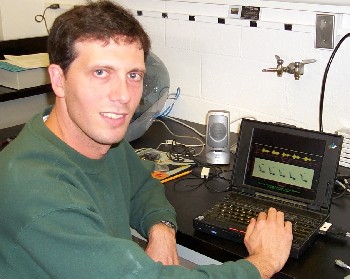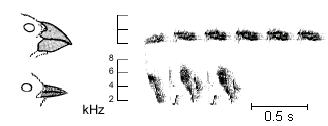Darwin's Finches Sing a Song about Food
The classical example of evolutionary diversification, Darwin's finches, is
in the news again. Jeff Podos, our new behavioral ecologist, has
just published evidence in the journal Nature in which he identifies
a possible cause for
 the rapid evolution of both vocalization and species diversity in Darwin's finches.
Jeff was awarded an NSF grant to study these phenomena. He is taking
annual field trips to the Galapagos to gather data to test his theories.
the rapid evolution of both vocalization and species diversity in Darwin's finches.
Jeff was awarded an NSF grant to study these phenomena. He is taking
annual field trips to the Galapagos to gather data to test his theories.
Jeff's research equipment includes audio and video recorders which allow him to
simultaneously capture the vocalizations and behavior of his target
species. To test his hypotheses, Jeff analyzes behavior, beak morphology,
and vocalizations. Experiments include the playing of high quality male
vocalizations to a female to see how she responds.
The audio recordings of bird song are transformed into sonograms which are plots
of time, frequency, and intensity of songs. The remarkable finding is
that,
in eight species of Darwin's finches, certain aspects of vocalization are
related to variation in beak structure (see sonograms at right for Geospiza
 fortis (upper) and Certhidea olivacea (lower) abstracted from his
Nature illustration).
Food availability could be a driving force for changes in beak structure which
might lead to behavioral isolation via mating incompatibilities.
Thus, two powerful interacting forces, feeding and communication at the time
of mating, could be the causative agents of rapid speciation.
fortis (upper) and Certhidea olivacea (lower) abstracted from his
Nature illustration).
Food availability could be a driving force for changes in beak structure which
might lead to behavioral isolation via mating incompatibilities.
Thus, two powerful interacting forces, feeding and communication at the time
of mating, could be the causative agents of rapid speciation.
Furthermore, in a number of species of Darwin's finches, beak structure has
been shown to vary from generation to generation, depending on the types of
available food.
This adds credence to Podos' theories of interplay between beak shape and
communication. Could the changes in food types over protracted time
intervals result in the selection of beak shapes that preclude vocalizations
once successful in attracting mates? This might select for species with
a more variable song repertoire.
In Jeff's hands, Darwin's finches have once again become a laboratory
for the study of evolution.